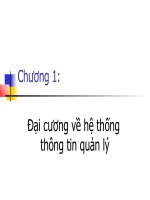Chapter 1 Multithreading
Bạn đang xem bản rút gọn của tài liệu. Xem và tải ngay bản đầy đủ của tài liệu tại đây (805.21 KB, 58 trang )
Chapter 1
Multithreading
Lecturer: Hồ Tiến Lâm
Contents
Threads Introduction
Interrupting Threads
Thread States
Thread Properties
Synchronization
Synchronization
Callables and Futures
2
GV. Hồ Tiến Lâm
Contents
Threads Introduction
Interrupting Threads
Thread States
Thread Properties
Synchronization
Synchronization
Callables and Futures
3
GV. Hồ Tiến Lâm
Threads Introduction
Multitasking: the ability to have more than one program
working at what seems like the same time.
Programs that can run more than one thread at once are
called mutithreaded programs.
What is the difference between multiple processes and
multiple
threads
?
4
multiple
threads
?
GV. Hồ Tiến Lâm
Threads Introduction (cont.)
Procedure for running a task in a separate thread:
1. Create a class that implements the Runnable interface and
put the code for doing task into that class:
public interface Runnable {
void run()
}
5
}
class MyRunnable implements Runnable {
public void run() {
// put task code here
}
}
GV. Hồ Tiến Lâm
Threads Introduction (cont.)
2. Create an object of your class:
Runnable r = new MyRunnable();
3. Create a Thread object from the Runnable:
Thread t = new Thread(r);
6
4. Start the thread:
t.start();
GV. Hồ Tiến Lâm
Contents
Threads Introduction
Interrupting Threads
Thread States
Thread Properties
Synchronization
Synchronization
Callables and Futures
7
GV. Hồ Tiến Lâm
Interrupting Threads
In JDK 1.0, there was a stop method which is used to
terminate another thread. But it's now deprecated.
Use the interrupt method to request termination of a
thread.
To check if one thread was interrupted:
Thread.currentThread
().
isInterrupted
()
8
Thread.currentThread
().
isInterrupted
()
If a thread is blocked, it cannot check the interrupted
status => throws InterruptedException
GV. Hồ Tiến Lâm
Interrupting Threads (cont.)
public void run() {
try {
…
while (!Thread.currentThread().isInterrupted()
&& more work to do) {
do more work
}
} catch(InterruptedException e) {
// thread was interrupted during sleep or wait
9
// thread was interrupted during sleep or wait
} finally {
cleanup, if required
}
// exiting the run method terminates the thread
}
The sleep method throws an
InterruptedException if you call it when the
interrupted status is set.
GV. Hồ Tiến Lâm
Interrupting Threads (cont.)
public void run() {
try {
…
while (more work to do) {
do more work
Thread.sleep(delay);
}
} catch(InterruptedException e) {
10
} catch(InterruptedException e) {
// thread was interrupted during sleep or wait
} finally {
cleanup, if required
}
// exiting the run method terminates the thread
}
GV. Hồ Tiến Lâm
Contents
Threads Introduction
Interrupting Threads
Thread States
Thread Properties
Synchronization
Synchronization
Callables and Futures
11
GV. Hồ Tiến Lâm
Thread States
There are 4 states:
• New
• Runnable
• Blocked
• Dead
New Threads:
12
New Threads:
• When you create a thread with new operator, the thread is not
yet running.
GV. Hồ Tiến Lâm
Thread States (cont.)
Runnable Threads:
• When you invoke the start method, the thread is runnable.
• Why is the state called “runnable” and not “running”?
A runnable thread may or may not be running at any given
time.
•
It is up to the OS to give the thread time to run (
time
-
slicing
)
13
•
It is up to the OS to give the thread time to run (
time
-
slicing
)
GV. Hồ Tiến Lâm
Thread States (cont.)
Blocked Threads:
• The thread goes to sleep by calling the sleep method.
• The thread calls an operation that is blocking on input/output.
• The thread tries to acquire a lock that is currently held by
another thread.
•
The thread waits for a condition.
14
•
The thread waits for a condition.
• Calls the suspend method of the thread. However, this
method is deprecated.
GV. Hồ Tiến Lâm
Thread States (cont.)
15
GV. Hồ Tiến Lâm
Thread States (cont.)
Dead Threads:
• It dies a natural death because the run method exits normally.
• It dies abruptly because an uncaught exception terminates the
run method.
• To check if a thread is currently alive (runnable or blocked), use
the
isAlive
method.
16
the
isAlive
method.
• NOTE: You cannot find out if an alive thread is runnable or
blocked, or if a runnable thread is running.
GV. Hồ Tiến Lâm
Contents
Threads Introduction
Interrupting Threads
Thread States
Thread Properties
Synchronization
Synchronization
Callables and Futures
17
GV. Hồ Tiến Lâm
Thread Priorities
In Java, every thread has a priority.
You can change the priority of any thread with the
setPriority method.
Range of priority:
• Thread.MIN_PRIORITY: 1
• Thread.NORM_PRIORITY: 5
• Thread.MAX_PRIORITY: 10
Thread priorities are highly system dependent.
18
GV. Hồ Tiến Lâm
Thread Priorities (cont.)
You should never structure your programs so that their
correct functioning depends on priority levels.
If you have several threads with a high priority that rarely
block, the lower-priority threads may never execute.
You cause the executing thread to yield by using
. If other runnable threads have a
Thread.yield()
. If other runnable threads have a
priority at least as high as the priority of this thread, they
will be scheduled next.
19
GV. Hồ Tiến Lâm
Daemon Threads
You can turn a thread into a daemon thread by calling
t.setDaemon(true);
A daemon is simply a thread that has no other role in life
than to serve others.
20
GV. Hồ Tiến Lâm
Thread Groups
This helps you simultaneously work with a group of
threads.
Construct a thread group:
String groupName = ; // this name must be
unique
ThreadGroup
g = new
ThreadGroup
g = new
ThreadGroup(groupName);
Add a thread to the thread group:
Thread t = new Thread(g, threadName);
To check whether any threads of a particular group are
still runnable, use the activeCount method.
21
GV. Hồ Tiến Lâm
Thread Groups (cont.)
To interrupt all threads in a thread group:
g.interrupt(); // g: an object of ThreadGroup
Thread groups can have child subgroups. You can specify
the parent group in the constructor, or by default a newly
created thread group becomes a child of the current thread
group.
group.
Method activeCount and interrupt refer to all
threads in their group and all child groups.
22
GV. Hồ Tiến Lâm
Contents
Threads Introduction
Interrupting Threads
Thread States
Thread Properties
Synchronization
Synchronization
Callables and Futures
23
GV. Hồ Tiến Lâm
Synchronization
What happen if two threads have access to the same object
and each calls a method that modifies the state of the
object?
Depending on the order in which the data were accessed,
corrupted objects can result.
That situation is called a
race
condition.
That situation is called a
race
condition.
24
GV. Hồ Tiến Lâm
An Example of a Race Condition
We simulate a bank with 100 accounts.
We randomly generate transactions that move money
between these accounts.
Each account has one thread.
Each transaction moves a random amount of money from
Each transaction moves a random amount of money from
the account to another random account.
The fact: total amount of money in all accounts does NOT
change whatever we run program for a long time.
25
GV. Hồ Tiến Lâm
LET’S SEE THE DEMO!









